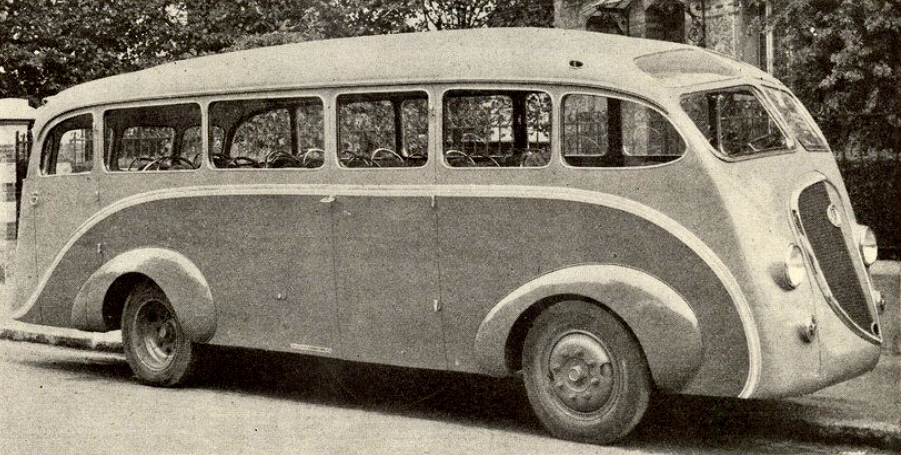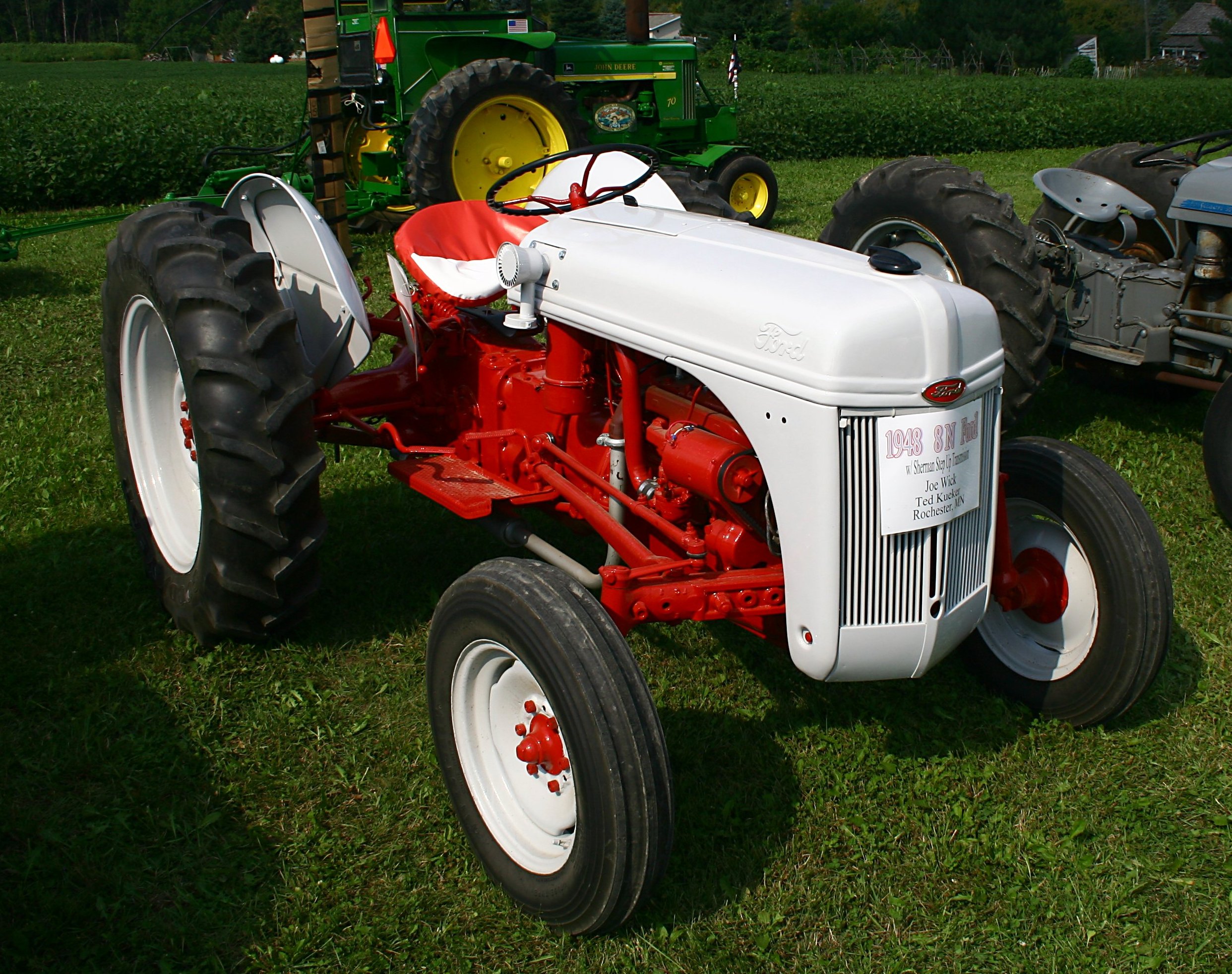|
Latil H14 TL10
The Latil H14 TL10 is an all-wheel drive agricultural and forestry tractor produced by Latil and later Saviem from 1947 to 1962 through various evolutions. It was replaced by the Saviem TL21/22/23 range. History In 1947, Latil unveiled its H14 TL10 agricultural and forestry tractor, mounting the H14 engine, a slightly modified H1. By 1949, it was sold in the United Kingdom as a multipurpose tractor (adding tractor unit for road and off-road) with the name H11 TL10. In the 1950s, TL10s equipped with a winch had some military use by engineering corps of the French Army. In 1957, after Latil was integrated into the Saviem company, a minor evolution of the TL10, the H14 TL12R, was introduced. In December 1960, the company unveiled the H14 TL12, a cheaper variant of the TL12R without trailer brake (which meant it could only be used as a towing tractor and not as an agricultural one). Technical details The main engine used for the tractor is the H14, an evolution of the pre-World War ... [...More Info...] [...Related Items...] OR: [Wikipedia] [Google] [Baidu] |
Latil
Automobiles Industriels Latil, commonly known as Latil, was a French manufacturer of commercial and military vehicles created to manage the assets of the defunct Compagnie Française d'Mecánique et d'Automobiles, to market Georges Latil's , an early front-wheel drive system. The company was established in 1909 by entrepreneur Charles Blum as Charles Blum & Cie. It started to use in the 1910s as a trading name. The company started to produce military vehicles by the 1910s and commercial ones in great numbers by the end of World War I. In 1928, the company adopted its trading name as its legal name. It was dissolved in 1955 after being merged into the Saviem group. History Early years and predecessors In 1898, Georges Latil and Aloïs Korn established an enterprise in Marseille ( Korn et Latil) to market a Latil invention, the , a kit to convert carriages into front-wheel drive vehicles. In 1901, Latil and Korn moved its operations to Levallois-Perret and created the to sell i ... [...More Info...] [...Related Items...] OR: [Wikipedia] [Google] [Baidu] |
Revolutions Per Minute
Revolutions per minute (abbreviated rpm, RPM, rev/min, r/min, or r⋅min−1) is a unit of rotational speed (or rotational frequency) for rotating machines. One revolution per minute is equivalent to hertz. Standards ISO 80000-3:2019 defines a physical quantity called ''rotation'' (or ''number of revolutions''), dimensionless, whose instantaneous rate of change is called ''rotational frequency'' (or ''rate of rotation''), with units of reciprocal seconds (s−1). A related but distinct quantity for describing rotation is ''angular frequency'' (or ''angular speed'', the magnitude of angular velocity), for which the SI unit is the radian per second (rad/s). Although they have the same dimensions (reciprocal time) and base unit (s−1), the hertz (Hz) and radians per second (rad/s) are special names used to express two different but proportional ISQ quantities: frequency and angular frequency, respectively. The conversions between a frequency and an angular frequency ... [...More Info...] [...Related Items...] OR: [Wikipedia] [Google] [Baidu] |
Tractors
A tractor is an engineering vehicle specifically designed to deliver a high tractive effort (or torque) at slow speeds, for the purposes of hauling a Trailer (vehicle), trailer or machinery such as that used in agriculture, mining or construction. Most commonly, the term is used to describe a farm vehicle that provides the power and traction to mechanization, mechanize agricultural tasks, especially (and originally) tillage, and now many more. List of agricultural machinery, Agricultural implements may be towed behind or mounted on the tractor, and the tractor may also provide a source of power if the implement is mechanised. Etymology The word ''tractor'' was taken from Latin, being the Agent (grammar), agent noun of ''trahere'' "to pull". The first recorded use of the word meaning "an engine or vehicle for pulling wagons or plows" occurred in 1896, from the earlier term "traction engine, traction motor" (1859). National variations In the United Kingdom, UK, Republic of ... [...More Info...] [...Related Items...] OR: [Wikipedia] [Google] [Baidu] |
Commercial Motor
''Commercial Motor'' is a weekly magazine serving the road transport Road transport or road transportation is a type of transport using roads. Transport on roads can be roughly grouped into the transportation of goods and transportation of people. In many countries licensing requirements and safety regulations e ... industry in the United Kingdom. Founded in 1905 by Edmund Dangerfield, it is notable for having been "the first journal to be devoted exclusively to the commercial vehicle engaged in the conveyance of goods or in passenger carrying". Originally named ''The Commercial Motor'', the title was shortened to ''Commercial Motor'' for the first issue of 1966. The publication is commonly referred to as 'CM' by its readers and editorial staff. ''Commercial Motor'' was initially published by Temple Press and since 2011 it has been published by Road Transport Media, part of DVV Media Group. Launch ''The Commercial Motor'' was launched in March 1905 by Temple Press. In ... [...More Info...] [...Related Items...] OR: [Wikipedia] [Google] [Baidu] |
Creusot-Loire
Creusot-Loire was a French engineering conglomerate, formed from factories in Le Creusot and Châteauneuf, Loire. The Creusot-Loire subsidiary of ArcelorMittal also includes an Innovation, Research and Development centre for the group. History The group was formed in 1970 as a result of Compagnie des ateliers et forges de la Loire (owned by Marine-Firminy) and (owned by Schneider) merger. The Société des Forges et Ateliers du Creusot had absorbed the Société métallurgique d'Imphy in 1968. The enterprise developed what has become known as the Creusot-Loire Uddeholm (CLU) converter process, which was developed to minimize the need of argon, and which was first erected on an industrial scale in the 1970s at Degerfors. The group was affected by the 1970s steel crisis, and was not able to pay a dividend after 1977. In 1984 the organisation became bankrupt with debts of $633 million; the company's owner Empain-Schneider rejected state aid as the conditions included giving aw ... [...More Info...] [...Related Items...] OR: [Wikipedia] [Google] [Baidu] |
Gross Vehicle Weight Rating
Vehicle weight is a measurement of wheeled motor vehicles; either an actual measured weight of the vehicle under defined conditions or a gross weight rating for its weight carrying capacity. Curb or kerb weight Curb weight (American English) or kerb weight (British English) is the total mass of a vehicle with standard equipment and all necessary operating consumables such as motor oil, transmission oil, brake fluid, coolant, air conditioning refrigerant, and sometimes a full tank of fuel, while not loaded with either passengers or cargo. The #Gross vehicle weight rating, gross vehicle weight is larger and includes the maximum payload of passengers and cargo. This definition may differ from definitions used by governmental regulatory agency, regulatory agencies or other organizations. For example, many European Union manufacturers include the weight of a driver and luggage to follow EU Directive 95/48/EC. Organizations may also define curb weight with fixed levels of fuel and othe ... [...More Info...] [...Related Items...] OR: [Wikipedia] [Google] [Baidu] |
Leaf Spring
A leaf spring is a simple form of spring (device), spring commonly used for suspension (vehicle), suspension in wheeled vehicles. Originally called a ''laminated'' or ''carriage spring'', and sometimes referred to as a semi-elliptical spring, elliptical spring, or cart spring, it is one of the oldest forms of vehicle suspension. A leaf spring is one or more narrow, arc-shaped, thin plates that are attached to the axle and chassis in a way that allows the leaf spring to flex vertically in response to irregularities in the road surface. Lateral leaf springs are the most commonly used arrangement, running the length of the vehicle and mounted perpendicular to the wheel axle, but numerous examples of transverse leaf springs exist as well. Leaf springs can serve multiple suspension functions: location, springing, and to some extent damping as well, through interleaf friction. However, this friction is not well controlled, resulting in stiction and irregular suspension motions. For t ... [...More Info...] [...Related Items...] OR: [Wikipedia] [Google] [Baidu] |
Air Brake (road Vehicle)
An air brake or, more formally, a compressed-air-brake system, is a type of friction brake for vehicles in which compressed air pressing on a piston is used to both release the parking/emergency brakes in order to move the vehicle, and also to apply pressure to the brake pads or brake shoes to slow and stop the vehicle. Air brakes are used in large heavy vehicles, particularly those having multiple trailers which must be linked into the brake system, such as trucks, buses, trailers, and semi-trailers, in addition to their use in railroad trains. George Westinghouse first developed air brakes for use in railway service. He patented a safer air brake on March 5, 1872. Westinghouse made numerous alterations to improve his air pressured brake invention, which led to various forms of the automatic brake. In the early 20th century, after its advantages were proven in railway use, it was adopted by manufacturers of trucks and heavy road vehicles. Design and function Air br ... [...More Info...] [...Related Items...] OR: [Wikipedia] [Google] [Baidu] |
Tonne
The tonne ( or ; symbol: t) is a unit of mass equal to 1,000 kilograms. It is a non-SI unit accepted for use with SI. It is also referred to as a metric ton in the United States to distinguish it from the non-metric units of the short ton ( United States customary units) and the long ton ( British imperial units). It is equivalent to approximately 2,204.6 pounds, 1.102 short tons, and 0.984 long tons. The official SI unit is the megagram (Mg), a less common way to express the same amount. Symbol and abbreviations The BIPM symbol for the tonne is t, adopted at the same time as the unit in 1879.Table 6 . BIPM. Retrieved on 2011-07-10. Its use is also official for the metric ton in the United States, having been adopted by the United States |
Four-wheel Steering
Steering is the control of the direction of motion or the components that enable its control. Steering is achieved through various arrangements, among them ailerons for airplanes, rudders for boats, cylic tilting of rotors for helicopters, and many more. Aircraft Aircraft flight control systems are normally steered when airborne by the use of ailerons, spoileron, or both to bank the aircraft into a turn; although the rudder can also be used to turn the aircraft, it is usually used to minimize adverse yaw, rather than as a means to directly cause the turn. On the ground, aircraft are generally steered at low speeds by turning the nosewheel or tailwheel (using a tiller or the rudder pedals) or through differential braking, and by the rudder at high speeds. Missiles, airships and large hovercraft are usually steered by a rudder, thrust vectoring, or both. Small sport hovercraft have similar rudders, but steer mostly by the pilot shifting their weight from side to side and unb ... [...More Info...] [...Related Items...] OR: [Wikipedia] [Google] [Baidu] |
Differential (mechanical Device)
A differential is a gear train with three drive shafts that has the property that the rotational speed of one shaft is the average of the speeds of the others. A common use of differentials is in motor vehicles, to allow the wheels at each end of a drive axle to rotate at different speeds while cornering. Other uses include clocks and analogue computers. Differentials can also provide a gear ratio between the input and output shafts (called the "axle ratio" or "diff ratio"). For example, many differentials in motor vehicles provide a gearing reduction by having fewer teeth on the pinion than the ring gear. History Milestones in the design or use of differentials include: * 100 BCE–70 BCE: The Antikythera mechanism has been dated to this period. It was discovered in 1902 on a shipwreck by sponge divers, and modern research suggests that it used a differential gear to determine the angle between the ecliptic positions of the Sun and Moon, and thus the phase of the Moon. ... [...More Info...] [...Related Items...] OR: [Wikipedia] [Google] [Baidu] |
Four-wheel Drive
A four-wheel drive, also called 4×4 ("four by four") or 4WD, is a two-axled vehicle drivetrain capable of providing torque to all of its wheels simultaneously. It may be full-time or on-demand, and is typically linked via a transfer case providing an additional output drive shaft and, in many instances, additional gear ranges. A four-wheel drive vehicle with torque supplied to both axles is described as "all-wheel drive" (AWD). However, "four-wheel drive" typically refers to a set of specific components and functions, and intended off-road application, which generally complies with modern use of the terminology. Definitions Four-wheel-drive systems were developed in many different markets and used in many different vehicle platforms. There is no universally accepted set of terminology that describes the various architectures and functions. The terms used by various manufacturers often reflect marketing rather than engineering considerations or significant technical diffe ... [...More Info...] [...Related Items...] OR: [Wikipedia] [Google] [Baidu] |





